|
 |
William Congreve
|
|
(24 January 1670 - 19 January 1729) was an English playwright and poet.
Congreve was born in Bardsey, West Yorkshire, England (near Leeds). His parents were William Congreve (1637-1708) and his wife, Mary; a sister was buried in London in 1672. He spent his childhood in Ireland, where his father, a Cavalier, had settled during the reign of Charles II. Congreve was educated at Trinity College in Dublin; there he met Jonathan Swift, who would be his friend for the remainder of his life. Upon graduation, he matriculated in the Middle Temple in London to study law, but felt himself pulled toward literature, drama, and the fashionable life. |
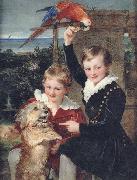 |
William Charles Ross
|
|
English Miniature Painter, 1794-1860
was a British painter. Early in his career, he was known for historical paintings, but he later gained fame for his miniatures and portraits. He was made a member of the Royal Academy in 1842. |
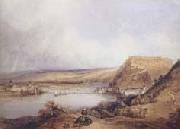 |
William Callow
|
|
British Painter, 1812-1908
1812-1908.English painter and engraver. The son of a carpenter and builder, Callow was apprenticed at the age of 11 to Theodore Fielding, with whom he remained for two years. Copley Fielding also took an interest in his progress. In 1825 Callow was articled to Theodore Fielding for eight years' instruction in watercolour drawing and aquatint engraving. However, in 1829 he left for Paris, at the invitation of Thales Fielding, to work for the publisher J. F. d'Ostervald. He lived and worked with Newton Fielding until 1830, when the events of the July Revolution forced them back to Britain. Callow was again in Paris by February 1831 and returned to London only in 1841. |
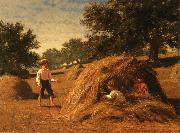 |
William Bliss Baker
|
|
(1859 - 1886-11-20) was an American artist born in New York City who was just beginning to hit his stride as a landscape painter in the Realism movement when he died at his father's house at Hoosick Falls, New York at the age of 27 due to a back injury received while ice skating several months earlier
Baker studied at the National Academy of Design for four years beginning in 1876,where he won first prize during his first exhibit in 1879. By 1881, Baker had set up a studio north of Albany, New York. |
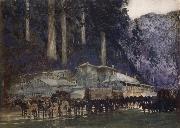 |
William Blamire Young
|
|
English Australian artist .
1862-1935
known as Blamire Young, was an English Australian artist. Young was born at Londesborough, Yorkshire, the second son of a family of 12. His father, Colonel Young, came of prosperous yeoman stock. Blamire Young was educated at the Forest School, Walthamstow, where he received a classical training, and going on to Cambridge University specialized in mathematics. That he completed his course with no better than third-class honours was no doubt partly caused by his discovery of the print collection in the Fitzwilliam Museum, and his association with the Cambridge Fine Art Society. It had been intended that he should become a clergyman, but Young felt that he had no vocation for that work and obtained the position of mathematical master at Katoomba College, Katoomba, New South Wales, which had been founded by John Walter Fletcher in 1884. Young remained at the school for eight years. In his spare time he practised painting, and meeting Phil May received some instruction from him in painting in oil. In 1893, he returned to England and after working for a few months under Hubert von Herkomer, became associated with James Pryde and William Nicholson in poster work. In 1895 Young returned to Australia and with the Lindsay brothers and Harry Weston did some excellent posters. But the field was limited and many years of poverty followed, during which a certain amount of writing was done for the press. He began exhibiting at the Victorian Artists' Society, but sales were few and the one-man show was then unknown. During his visit to England he had married Mabel Sawyer, an expert wood-carver, and while the lean period lasted Mrs Young helped to keep the house going by executing commissions for Melbourne architects. It was not until 1911 that the appreciation of Young's art really began to be shown. In that year he held an exhibition at Melbourne of small pictures, some of which had similar qualities to the Japanese coloured wood-cuts of the eighteenth century. Sales were good, partly because the prices were low, and the artist was sufficiently encouraged to hold an exhibition at Adelaide. This was both an artistic and a financial success, other shows followed in Melbourne and Sydney, and at last, in his fiftieth year, Young's reputation as an artist was established. In 1912 he sailed for Europe and after a stay in Spain settled in England. Eighteen months later in August 1914 his first show, opened at the Bailey Galleries. All the arrangements had been made and the pictures hung when war broke out. Young had been a good marksman in his youth, and for three years worked as an instructor in musketry and machine-gunnery. Immediately after the war he took up his painting again and exhibited at the Academy and the Royal Society of British Artists. Back in Australia in 1923 Young established himself at Montrose in the hills about 20 miles east of Melbourne. He acted as art critic for the The Herald and held occasional one-man shows. |
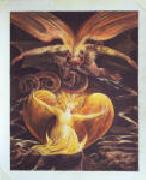 |
William Blake
|
|
1757-1827
British
William Blake Galleries
William Blake started writing poems as a boy, many of them inspired by religious visions. Apprenticed to an engraver as a young man, Blake learned skills that allowed him to put his poems and drawings together on etchings, and he began to publish his own work. Throughout his life he survived on small commissions, never gaining much attention from the London art world. His paintings were rejected by the public (he was called a lunatic for his imaginative work), but he had a profound influence on Romanticism as a literary movement.
|
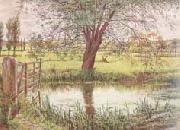 |
William Bell Scott
|
|
1811-1890
Brother of David Scott. He trained at the Trustees' Academy in Edinburgh and was taught engraving by his father. He saw the family print workshop as 'the lineal descendant of Albert Derer's factory in Nernberg'; he was later to own a fine collection of D?rer's prints and write a book about him (1870). In 1837 he went to London, where he was impressed by 'a new and interesting school of historical and loosely speaking, inventive and illustrative painters'. This encouraged him to leave landscape painting for the time being and become a history painter. Like his brother, he entered a cartoon for the Westminster Hall competition in 1842: the Free North Britons Surprising the Roman Wall between the Tyne and Solway; this too was unsuccessful. In 1843, discouraged by lack of patronage in London, he accepted the Mastership of the Government School of Design at Newcastle upon Tyne, where he stayed for 20 years, visiting London each summer. |
 |
William Barak
|
|
Australian Aboriginal, ca.1824-1903
was the last traditional ngurungaeta (elder) of the Wurundjeri-willam clan, based around the area of present-day Melbourne, Australia. He became an influential spokesman for Aboriginal social justice and an important informant on Wurundjeri cultural lore. Barak was born in the early 1820s at Brushy Creek near present-day Croydon, in the country of the Wurundjeri people. His mother, Tooterrie, came from the Nourailum bulluk at Murchison, Victoria. His father, Bebejern, was an important member of the Wurundjeri clan. Beruk was said to have been present when John Batman met with the tribal elders to 'purchase' the Melbourne area in 1835. Before he died he described witnessing the signing of the treaty in a ceremony he called a tanderem. Ninggalobin, Poleorong and Billibellary were the leading song makers and principal Wurundjeri leaders in the Melbourne region. European colonisation had caused disruptions to initiation ceremonies. In response these three men gathered at South Yarra in the late 1830s and inducted the young William Barak into Aboriginal lore. This entailed formally presenting Barak with the symbols of manhood: strips of possumskin tied around his biceps; the gombert around his neck; given his ilbi-jerri, a sharp and narrow bone or nose-peg; and his branjep, the apron worn by men to cover their genitals. At the end of the ceremony Barack presented his uncle, Billibellary, a possumskin cloak. Beruk attended the government's Yarra Mission School from 1837 to 1839. When he joined the Native Mounted Police in 1844, he was given the name of William Barak. He was Police Trooper No.19. In early 1863, Barak moved to Coranderrk Station, near Healesville, Victoria with about thirty others. Upon the death of Simon Wonga in 1875, Barak became the Ngurungaeta of the clan. He worked tirelessly for his people and was a successful negotiator on their behalf. He was a highly respected man and leader, with standing amongst the Indigenous people and the European settlers. Figures in possum-skin cloaks, 1898 by William Barak.Barak is now best remembered for his artworks, which show both traditional Indigenous life and encounters with Europeans. Most of Barak's drawings were completed at Coranderrk during the 1880s and 1890s. They are now highly prized and exhibited in leading public galleries in Australia. His work is on permanent display in the National Gallery of Victoria Ian Potter Centre at Federation Square, Melbourne. Ceremony (1895) is housed at the Ballarat Fine Art Gallery. Barak died at Coranderrk in 1903 and is buried at the Coranderrk cemetery. |
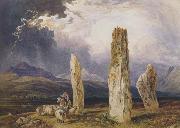 |
William Andrews Nesfield
|
|
British Painter, 1793-1881
was born in Lumley Park, County Durham. In 1808, after the death of William's mother, the family moved the few miles to Brancepeth where his father became rector of St Brandon's Church. His stepmother was Marianne Mills of Willington Hall, whose nephew was the noted architect Anthony Salvin. William's younger sister in fact married Salvin. Nesfield was educated at Durham School, then located on Palace Green, before entering the army. He fought under Wellington in Spain and at Waterloo and also served for two years in Canada. He retired in 1816 and took up a career as a painter of watercolours, particularly of waterfalls, earning the praise of John Ruskin in Modern Painters. While still exhibiting at the Old Water Colour Society, Nesfield began work as a professional landscape architect, with the encouragement of Salvin. From 1840 until his death he was responsible, either singly or with his sons Arthur Markham and William Eden for no fewer than 259 commissions in the British Isles. |
 |
William Anderson
|
|
William Anderson (1757 - 27 May 1837) was born in Scotland and became an artist specializing in maritime and patriotic themes..
Anderson's training as a shipwright stood him in good stead when he became an artist specializing in maritime art based on the Dutch 17th century Masters. He first exhibited at the Royal Academy in 1780 and continued to exhibit annually until 1811. He then exhibited intermittently until 1834. His best work was executed in the years 1790-1810, during the French Revolutionary and Napoleonic Wars, at which time the demand for naval paintings was high. He painting was not restricted to marine subjects.
His pictures, shown at exhibitions, include A View of Berwick-on-Tweed and A View of Tynemouth. His history paintings include The Battle of Waterloo, The Capture of Fort Louis, Martinique, 1794, which shows the attack by Commander Robert Faulknor of Zebra on Fort Saint Louis (Martinique), The Battle of Cape Finisterre, The First Battle of Groix and The Battle of the Nile . Other paintings include Shipping on the Thames at Deptford and View at the mouth of the Thames ..
|
 |
William Alexander Coulter
|
|
(March 7, 1849 - March 13, 1936) was an American painter of marine subjects. Coulter was a native of Glenariff, County Antrim, in what is today Northern Ireland. He became an apprentice seaman at the age of 13, and after seven years at sea, came to settle in San Francisco in 1869. In the late 1870s, he went to Europe to study with marine artists Vilhelm Melbye, François Etienne Musin, and J. C. Jacobsen. In 1896, he joined the art staff of the San Francisco Call. Between 1909 and 1920, he painted five 16 by 18 foot murals for the Assembly Room of the Merchants Exchange Building. Coulter resided in the San Francisco Bay Area until his death at the age of 87, in his Sausalito home. During the course of his life, his paintings chronicled the history of shipping and navigation in the San Francisco and San Pablo bays. |
 |
William Aikman
|
|
William Aikman (24 October 1682 - 7 June 1731) was a Scottish portrait-painter.
Aikman was the son of William Aikman, of Cairney. His father intended that he should follow the law, and gave him an education suitable to these views; but the strong predilection of the son to the fine arts induced him to attach himself to painting alone. Poetry, painting, and music have, with justice, been called sister arts. Mr. Aikman was fond of poetry; and was particularly delighted with those unforced strains which, proceeding from the heart, are calculated to touch the congenial feelings of sympathetic minds. It was this propensity that attached him so warmly to Allan Ramsay, the Doric bard of Scotland. Though younger than Ramsay, Mr. Aikman, while at college, formed an intimate acquaintance with him, which constituted a principal part of his happiness at that time, and of which he always bore the tenderest recollection. It was the same delicate bias of mind which at a future period of his life attached him so warmly to Thomson, who then unknown, and unprotected, stood in need of, and obtained the warmest patronage of Aikman; who perhaps considered it as one of the most fortunate occurrences in his life that he had it in his power to introduce this young poet of nature to Sir Robert Walpole, who wished to be reckoned the patron of genius, and to Arbuthnot, Swift, Pope, Gay, and the other beaux esprits of that brilliant period. Thomson could never forget this kindness; and when he had the misfortune, too soon, to lose this warm friend and kind protector, he bewailed the loss in strains distinguished by justness of thought, and genuine pathos of expression. |
 |
Willem Wissing
|
|
Willem Wissing, also known as William Wissing (1656 - 10 September 1687), was a Dutch portrait artist.
He was born in either Amsterdam or The Hague, and studied at The Hague under Willem Doudijns (1630 - 97) and Arnoldus van Ravestyn (1615 - 90). In 1676, he moved to England, where he studied with and assisted Peter Lely. After Lely's death in 1680, Wissing emerged as his most important pupil. Godfrey Kneller was the only contemporary portrait artist in England to rival Wissing. Wissinges royal sitters include Charles II of England, Queen Catharine of Braganza, Prince George of Denmark and James Scott, 1st Duke of Monmouth. |
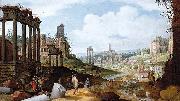 |
Willem van Nieulandt
|
|
(1584-1635) was a Dutch Golden Age painter and engraver from Antwerp.
His father Adrien van Nieulandt the elder was born to a family of artists of Flemish origin from Antwerp. He probably moved with his family to Amsterdam in 1589 after the Siege of Antwerp, because they were Protestants. His three sons Willem van Nieulandt II (named for his uncle, also a painter), Adriaen van Nieulandt the younger, and Jacob van Nieulandt all became painters.
According to Houbraken, Willem was a pupil of Roelant Savery in Amsterdam, and he left him to travel to Rome, where he became a student of Paulus Bril. He specialized in painting artistic ruins of monuments, arches, and temples, many of which he then engraved himself. He returned to Amsterdam (via Antwerp) in 1607, and became a respected poet there as well as Italianate painter.
|
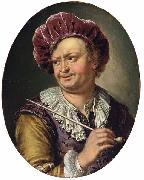 |
Willem van Mieris
|
|
(3 June 1662, Leiden - 26 January 1747, Leiden) was a Dutch painter. He was a son of Frans van Mieris sr. and brother of Jan van Mieris.
His works are extremely numerous, being partly imitations of the paternal subjects, or mythological episodes, which Frans habitually avoided. In no case did he come near the excellence of his sire.
van Mieris has works in the Victoria and Albert Museum as well as Cheltenham and Derby Museum and Art Gallery
|
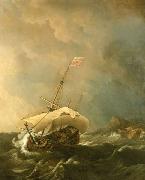 |
Willem Van de Velde The Younger
|
|
(bapt. 18 December 1633 - 6 April 1707) was a Dutch marine painter.
Willem van de Velde was baptised on 18 December 1633 in Leiden, Holland, Dutch Republic.
A son of Willem van de Velde the Elder, also a painter of sea-pieces, Willem van de Velde, the younger, was instructed by his father, and afterwards by Simon de Vlieger, a marine painter of repute at the time, and had achieved great celebrity by his art before he came to London. In 1673 he moved to England, where he was engaged by Charles II, at a salary of £100, to aid his father in "taking and making draughts of sea-fights", his part of the work being to reproduce in color the drawings of the elder van de Velde. He was also patronized by the Duke of York and by various members of the nobility.
He died on 6 April 1707 in London, England. |
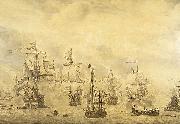 |
Willem van de Velde the Elder
|
|
(c. 1611 - 13 December 1693) was a Dutch Golden Age seascape painter.
Willem van de Velde, known as the Elder, a marine draughtsman and painter, was born in Leiden, the son of a Flemish skipper, Willem Willemsz. van de Velde, and is commonly said to have been bred to the sea. In 1706 Bainbrigg Buckeridge noted that he eunderstood navigation very welle. He married Judith Adriaensdochter van Leeuwen in Leiden, the Netherlands, in 1631.
His three known legitimate children were named Magdalena, born 1632; Willem, known as the Younger, also a marine painter, born 1633; and Adriaen, a landscape painter, born 1636.
His marriage was stormy, at least in its later years. David Cordingly relates that Willem the Elder fathered two children out of wedlock in 1653, one eby his maidservant, and the other by her friend. Nine years later the Elder and his wife went through a legal separation, eon account of legal disputes and the most violent quarrelse. The immediate cause of the dispute was his affair with a married woman.e Michael S. Robinson noted that eon 17/27 July 1662, he and his wife agreed to part. A condition of the separation was that the Elder could recover from his son Adriaen etwo royal giftse, presumably gifts from Charles II for work done in England.e Cordinglyes account further relates that the dispute was still continuing after another ten years, since ein the autumn of 1672 Judith complained to the womanes husband.e Robinson adds that by 1674 the couple emust have been reconcilede, for at a chance meeting with Pieter Blaeu in Amsterdam in July the Elder explained that he was only visiting for a few days ein order to fetch his wifee. His son, Adriaen, had died in Amsterdam in 1672, and Willem the Elder was also fetching his grandson, similarly named Adriaen, who was then aged two.
After his move to England, the exact date of which is uncertain, but reportedly at the end of 1672 or beginning of 1673, he is said to have lived with his family in East Lane, Greenwich, and to have used the Queenes House, now part of the National Maritime Museum in Greenwich, as a studio. Following the accession of William and Mary as King and Queen of England, it appears that this facility was no longer provided, and by 1691 he was living in Sackville Street, now close to Piccadilly Circus. He died in London, and was buried in St Jameses Church, at the south end of the street.
|
 |
willem van de velde the younger
|
|
(bapt. 18 December 1633 - 6 April 1707) was a Dutch marine painter.
Willem van de Velde was baptised on 18 December 1633 in Leiden, Holland, Dutch Republic.
A son of Willem van de Velde the Elder, also a painter of sea-pieces, Willem van de Velde, the younger, was instructed by his father, and afterwards by Simon de Vlieger, a marine painter of repute at the time, and had achieved great celebrity by his art before he came to London. In 1673 he moved to England, where he was engaged by Charles II, at a salary of £100, to aid his father in "taking and making draughts of sea-fights", his part of the work being to reproduce in color the drawings of the elder van de Velde. He was also patronized by the Duke of York and by various members of the nobility.
He died on 6 April 1707 in London, England. |
 |
Willem van Bemmel
|
|
(Utrecht 10 June 1630 - Nuremberg 20 December 1708), was a Dutch Golden Age painter active in Germany.
Van Bemmel was a student of Herman Saftleven in Utrecht. He made a Grand Tour to Rome, spending first the years 1647-9 in Venice where he became famous for his landscapes. He stayed in Rome for six years and was a member of the Bentvueghels. From Rome he crossed the Alps to Nuremberg, where he became a successful painter of Italianate landscapes.
In 1656 he moved to Kassel. He was the father of the German Von Bemmel painting family.
|
 |
Willem van Aelst
|
|
(May 16, 1627 - in or after 1683) was a Dutch artist who specialized in still-life painting with flowers or game.
Van Aelst was born in Delft to a family of prominent city magistrates. He learned to paint from his uncle, the still-life painter Evert van Aelst. On 9 November 1643 he enrolled as a master of the Guild of Saint Luke at Delft.
Between 1645 and 1649 he lived in France. In 1649 Van Aelst travelled to Florence, where he served as court painter to Ferdinando II de' Medici, grand duke of Tuscany. At this time, the grand duke also employed two fellow Dutchmen Matthias Withoos and Otto Marseus van Schrieck, the latter also a still-life painter who probably influenced Van Aelst's style.
In 1656 he returned to the Netherlands to settle permanently in Amsterdam. He became one of the most prominent still-life painters of his generation, which allowed him to live on the Prinsengracht. He must have at Amsterdam died in 1683 or shortly thereafter, as his latest dated work is from that year. Van Aelst taught Rachel Ruysch and several others.
|
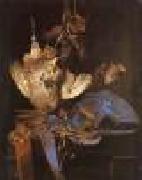 |
Willem van
|
|
Dutch Baroque Era Painter, 1627-ca.1683 |
 |
Willem Roelofs
|
|
Dutch Painter, 1822-1897
Dutch painter. He is said to have made his first sketches at the age of four; at fifteen he completed his first landscape painting. Many of these early works are in the print rooms of the Rijksmuseum, Amsterdam, and the Gemeentemuseum, The Hague. In c. 1837-8 he was apprenticed to the amateur painter Abraham Hendrik de Winter (1800-61) in Utrecht, where the Roelofs family had moved in 1826. In 1838 he entered his first paintings in the Exhibition of Living Masters in Amsterdam and Rotterdam. In the late summer of 1840 Roelofs became a pupil of the landscape and animal painter Hendrik van de Sande Bakhuyzen (1795-1860), with whom he made a study trip to Germany in 1841. Roelofs took a special interest in nature: he applied himself energetically both to painting and drawing, almost always selecting landscape subjects. He also studied entomology and accumulated a large collection of insects. After his training he returned to his parents in Utrecht. |
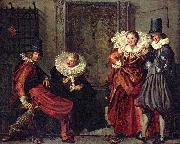 |
Willem Pieterszoon Buytewech
|
|
(1591/1592, Rotterdam - September 23, 1624, Rotterdam) was a Dutch painter, draughtsman and etcher of the Golden Age. He is often considered the "inventor" of Dutch genre painting. For his preference of irony, his contemporaries named him Gheestige Willem (Jolly or spiritual William).
Buytewech was the son of Pieter Jacobsz, a cobbler and candlemaker. He learned his trade in Haarlem, where he became a member of the artists' guild (Haarlem Guild of St. Luke) in 1612, together with Hercules Segers and Esaias van de Velde.[1] Frans Hals, who was a member of this guild since 1610, had much influence on Buytenwech's work, as shown by the many drawings that the latter made after Hals's paintings. After his marriage on November 10, 1613 with Aeltje van Amerongen, of a patrician family, he returned to Rotterdam. There Hendrik Martenszoon Sorgh was one of his pupils.
Buytewech was primarily a graphic artist, mostly of landscapes and genre pieces, but occasionally also of biblical and allegorical themes. Of his paintings only eight have survived to this date, all genre pieces, most depicting merry companies.
Willem Buytewech's Merry CompanyHe died at the age of only 32 or 33 of unrecorded causes. His son Willem Willemsz Buytewech (1625-1670), born after his death, would become a painter as well. |
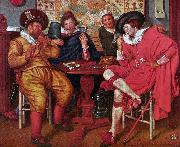 |
Willem Pietersz. Buytewech
|
|
Willem Pieterszoon Buytewech (1591/1592 - September 23, 1624) was a Dutch painter, draughtsman and etcher of the Golden Age. He is often considered the "inventor" of Dutch genre painting. For his preference of irony, his contemporaries named him eGheestige Willeme (Jolly or spiritual William).
|
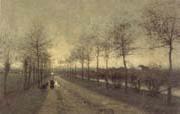 |
Willem Maris
|
|
Dutch Painter, 1844-1910
Brother of Jacob Maris. He received his training as a painter from his brothers, Jacob Maris and Matthijs Maris. Although he briefly attended evening classes at the Academie in The Hague and was advised by the animal painter Pieter Stortenbeker (1828-98), he was basically self-taught; he was the only self-made man in the circle of Hague school artists. In 1862 he visited Oosterbeek where he met Anton Mauve, with whom he established a long friendship. In the same year he first entered a painting, Cows on the Heath (untraced), in the Tentoonstellung van Levende Meesters in Rotterdam. The themes of cows at pasture and ducks by the side of a ditch, which characterized the Dutch polder landscape in summer, became his hallmark. In the following year he exhibited Cows by a Pool (The Hague, Gemeentemus) in The Hague; it received discouraging reviews, as did the picture entered by his brother Matthijs. Painted in 1863, this work already employs Willem main motif and shows his attention to the handling of light (with effects of haze and backlighting). |
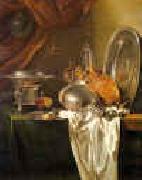 |
Willem Kalf
|
|
1619-1693
Dutch
Willem Kalf Galleries
Willem Kalf was born in Rotterdam, in 1619. He was previously thought to have been born in 1622, but H. E. van Gelder??s important archival research has established the painter??s correct place and date of birth. Kalf was born into a prosperous patrician family in Rotterdam, where his father, a cloth merchant, held municipal posts as well. In the late 1630s, Willem Kalf travelled to Paris and spent time in the circle of the Flemish artists in Saint-Germain-des-Pr??s, Paris. In Paris he painted mainly small-scale rustic interiors and still-lifes. Kalf??s rustic interiors are typically dominated by groups of vegetables, buckets, pots and pans, which he arranged as a still-life in the foreground (e.g. Kitchen Still-life, Dresden, Gemäldegal; Alte Meister). Figures usually appeared only in the blurred obscurity of the background. Though painted in Paris, those pictures belong to a pictorial tradition practised primarily in Flanders in the early 17th century, by such artists as David Teniers the Younger. The only indication of the French origin of the paintings are a few objects that Flemish exponents of the same genre would not have pictured in their works. Kalf??s rustic interiors had a large influence on French art in the circle of the Le Nain brothers. The semi-monochrome still-lifes which Kalf created in Paris form a link to the banketjes or 'little banquet pieces' painted by such Dutch artists as Pieter Claesz, Willem Claeszoon Heda and others in the 1630s. During the 1640s, Kalf further developed the banketje into a novel form of sumptuous and ornate still-life (known as pronkstilleven), depicting rich groupings of gold and silver vessels. Like other still-lifes of this period, these paintings were usually expressing vanitas allegories. |
 |
Willem Eversdijck
|
|
the son of Cornelis Eversdijck, flourished at Goes about the year 1660. He was a portrait painter, and several of his portraits were engraved by Houbraken. A picture of Officers and Members of the Company of Archers, called " Edele Voetboog," at Goes, by him, is in the Rotterdam Museum.
Cornelis Willemsz Eversdijck, his father, was also a portrait painter of Goes, who died there in 1649. In the Rotterdam Museum are three pictures by him, representing Officers and Members of the Company of Archers, called "Edele Voetboog," at Goes; two of which are dated 1616 and 1624.
|
 |
Willem Drost
|
|
Dutch Baroque Era Painter, ca.1630-1680
Dutch painter, draughtsman and printmaker, possibly of German origin. According to Houbraken, he was a pupil of Rembrandt, possibly in or shortly before 1650. An early etching signed w drost 1652 is probably a self-portrait, in which Drost portrayed himself as a young man drawing. His earliest dated paintings are two pendants of 1653: the Portrait of a Man (New York, Met.) and the Portrait of a Woman . |
 |
Willem de Zwart
|
|
(16 May 1862 The Hague - 11 December 1931 The Hague) was a Dutch painter, engraver, watercolorist, with many connections to the Hague School.
Willem De Zwart was born in The Hague on 16 May 1862, the eldest of eight children. His youngest brother, Pieter, would also become a painter. His father painted carriages for a living, and in 1875 the fourteen-year-old Willem was apprenticed to a carriage maker to learn the same trade. In his spare time, he copied prints he found in magazines, and a year later he enrolled in the evening class at the Royal Academy of Visual Art in The Hague. The following year, he was admitted at the studio of Jacob Maris. In the three years that he remained here, it is probable that he got to know many of the leading lights of the Hague School. Maris also sent De Zwart on a journey to the coast, without drawing materials, and had him work out his impressions directly on canvas when he returned to the studio.
De Zwart made several copies of works by 16th and 17th century masters in the Mauritshuis. He was most interested in the works of Johannes Vermeer, Paulus Potter, and Rembrandt, but studied paintings by German and Italian masters, as well. Sometimes he produced copies on commission. In this period, he also made detailed studies of animals, concentrating particularly on their legs, heads and snouts. De Zwart developed a fastidious painting style with a sober, predominantly brown palette.
Willem de Zwart lived and worked until 1894 in The Hague and from 1900 to 1905 in Amsterdam. His work has a wide range of subjects: landscapes, cityscapes, portraits and still life, rendered in a naturalistic or impressionist style. His work shows affinity with the people and city-oriented Amsterdam Impressionism. In his choice of subjects belonged to the Hague School and in his style and his exuberant use of color to the school of Amsterdam Impressionism. He is also known as the "Hague Breitner" because of the similarity of his work to that of George Hendrik Breitner. He painted his landscapes, figure paintings and still lifes with smooth, bold brushstrokes. De Zwart applied the paint thickly, sometimes straight from the tube, with bright colors, exuberant reds, yellows and blues, giving his paintings special vibrancy.
|
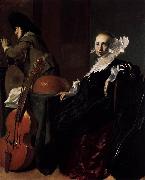 |
Willem Cornelisz. Duyster
|
|
(1599-1635) was a Dutch Golden Age painter from Amsterdam.
According to the RKD, his name was taken from his house on the Amsterdam Koningstraat, which was called "De Duystere Werelt", the dim world. He was a pupil of Pieter Codde. He married the sister of the painter Simon Kick (1603-1652), who himself married Willem's sister. |
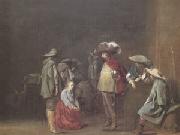 |
Willem Cornelisz Duyster
|
|
Willem Cornelisz Duyster (1599 ?C 1635) was a Dutch painter from Amsterdam.
Duyster paintings generally depicted genre scenes and portraits, quite often of soldiers. He exhibited a strong ability to paint textiles, accurately characterize his subjects, and to depict relationships between his figures. Duyster career was cut short when he succumbed to the plague in 1635. |
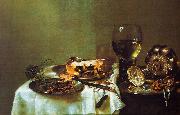 |
Willem Claesz Heda
|
|
1594-1682
Dutch
Willem Claesz Heda Galleries
Dutch painter. He was a still-life painter, who, like Pieter Claesz., is noted for his monochrome breakfast-pieces, which are, however, more opulent than those of Claesz. Heda earliest dated work is a Vanitas (1621; The Hague, Mus. Bredius), which shows a still-life from a high viewpoint, composed of various objects bearing vanitas associations (e.g. a bowl of glowing embers, smoker requisites, an overturned glass and a skull); the colouring is in brownish-grey tones and represents one of the earliest examples of a Dutch monochrome still-life (monochrome refers to the range of tones, rather than of colours). Even in this early work Heda skill at painting textures is evident. A more balanced composition is achieved in another Still-life (1629; The Hague, Mauritshuis) and in the Breakfast Table (1631; Dresden, Gemeldegal. Alte Meister), in both of which the objects, set against a neutral background, are linked by a strong diagonal. The Mauritshuis still-life also gives an early indication of Heda interest in painting the effects of light. In 1631 he became a member of the Haarlem Guild of St Luke (of which he served as deacon on several occasions after 1637). |
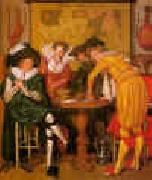 |
Willem Buytewech
|
|
1591-1624
Dutch Willem Buytewech Locations
Dutch painter, draughtsman and etcher. Although he was born and died in Rotterdam, stylistically he belongs to the generation of young artists working in Haarlem at the beginning of the 17th century. He was nicknamed Geestige Willem (Dut.: inventive, or witty, Willem) by his contemporaries, and during his short career he made an important and highly personal contribution to the new approach to realism in Dutch art. He was one of the first to paint interiors with merry companies (see CONVERSATION PIECE) and is primarily known for his lively and spontaneous drawings and etchings on a wide range of subjects. |
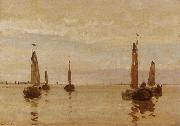 |
Willem Bastiaan Tholen
|
|
was a Dutch painter, draftsman and printmaker, born in Amsterdam, 13 Feb 1860, died in The Hague, 5 Dec 1931. He came from an artistic family, who lived in Kampen from 1864. There he developed at an early age a lasting love of the Zuiderzee. In Kampen he became friendly with the young Jan Voerman; they entered the Amsterdam academy together in 1876, where Tholen studied under August Allebe. Subsequently he learned technical drawing at the Polytechnische School in Delft until 1878. Thereafter he spent three months in the studio of Paul Gabriël in Brussels, from whom he received his first real instruction in painting. In the following years Gabriël's advice was of particular importance for Tholen, as they worked together en plein air for many summers near Kampen and Giethoorn, among other places. In Gouda (1878-9) and Kampen (1880-85) he taught draftsmanship in order to support himself but after 1885 concentrated entirely on his own work. From 1887 he lived in The Hague, where he became friendly with the painters of The Hague school. He took an active part in the artistic life of The Hague and was a member of the Pulchri Studio.
|
 |
Willem Drost
|
|
Dutch Baroque Era Painter, ca.1630-1680
Dutch painter, draughtsman and printmaker, possibly of German origin. According to Houbraken, he was a pupil of Rembrandt, possibly in or shortly before 1650. An early etching signed w drost 1652 is probably a self-portrait, in which Drost portrayed himself as a young man drawing. His earliest dated paintings are two pendants of 1653: the Portrait of a Man (New York, Met.) and the Portrait of a Woman (The Hague, Mus. Bredius). The man portrait is signed Wilhelmus Drost F. Amsterdam 1653; the form of the first name implies that he was of German descent. |
|

